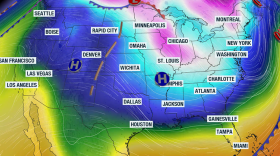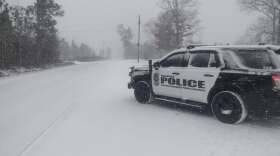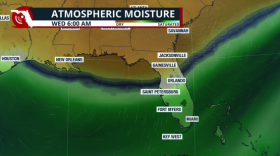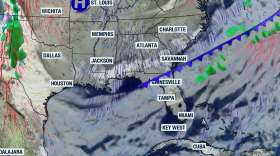Resource Links | Important Numbers | Terms To Know | Storm News
It’s that time of year again. Florida’s hurricane season lasts from June 1 until November 30. If you’re new to the state or just in need of information on how to keep yourself and your loved ones safe, the Central Florida Public Media news team has compiled links to some of the most important information you’ll need.
Stay Safe this hurricane season and remember, Central Florida Public Media is here to keep you up-do-date with life and property saving information.
RESOURCE LINKS
CENTRAL FLORIDA COUNTY EMERGENCY INFORMATION, SHELTERS AND EVACUATION ZONES:
Brevard | Lake | Marion | Orange | Osceola | Polk | Seminole | Sumter | Volusia | Flagler
STATE/NATIONAL RESOURCES:
NOAA | Fla. Div. Of Emergency Management | FEMA
MORE RESOURCE LINKS:
Disaster Supply Kit Checklist
Flood maps
Know your Zone
Evacuation plan
Shelters
Preparing your homes
Medicine refills
Hurricane safety for people with dementia
Special Needs Registry
Planning for your pet
Horse owner hurricane preparation
Mental health help during a disaster
What to do if you lose power
Power outage map
Dangers after a hurricane
Cleanup after a hurricane
Food Safety
Generator safety
Where to find gas
Report price gouging
Mosquitoes after a storm
Encountering wildlife after a hurricane
Beekeeper preparedness
IMPORTANT NUMBERS
Emergency help: 911
SAIL Hotline: 1-800-342-3557
FEMA: 1-800-621-FEMA (3362)
Non Emergency Support Services: 211
TERMS TO KNOW
Language surrounding hurricanes and other storms can often be confusing. With that in mind, we’ve also compiled a list of terms and their definitions.
Tropical Cyclone: Low pressure system that forms over warm tropical waters.
Tropical Depression: A tropical cyclone with maximum sustained winds of 38 mph or less.
Tropical Storm: A tropical cyclone with maximum sustained winds of 39 to 73 mph.
Hurricane: A tropical cyclone with maximum sustained winds of 74 mph or higher.
Major hurricane: A tropical cyclone with maximum sustained winds of 111 mph or higher. These are category 3, 4 or 5 hurricanes.
Tropical storm warning: A tropical storm warning is issued when sustained winds of 39 to 73 mph are expected in an area within the next 36 hours.
Tropical storm watch: A tropical storm watch is issued when tropical storm conditions are possible within the next 48 hours.
Hurricane Warning: A hurricane warning is issued when sustained winds of 74 mph or greater are expected in an area within the next 36 hours.
Hurricane Watch: A hurricane watch is issued when hurricane force winds are possible in an area within the next 48 hours.
Eye: The center of the hurricane.
Eyewall: The band or ring of clouds that surrounds the eye of a hurricane.
Landfall: The moment the center of the hurricane reaches the coastline.
Outer bands: An outer ring of rainfall and thunderstorms that surrounds a hurricane. Usually this is the first part of the storm to make landfall.
Storm surge: A rise in sea level corresponding with a hurricane or other intense storm at sea.
Cone of uncertainty: A diagram showing the projected path of a tropical storm or hurricane over the next five days.
Spaghetti plot: A diagram showing multiple paths a tropical storm or hurricane could take based on different prediction models.
Hurricane names: Any tropical cyclone that becomes a tropical storm or hurricane gets a name. Here’s the list of this year’s names.
National Hurricane Center: The National Hurricane Center or NHC issues watches, warnings and advisories for tropical weather.
Hurricane season: The Atlantic hurricane season runs from June 1 through November 30. This is when tropical cyclones are most likely to form in the Atlantic.
The peak of hurricane season: September 10 is the peak of hurricane season. Most hurricanes form between mid-August and mid-October.
Saffir Simpson Hurricane Wind Scale (ranking): The scale ranks a hurricane’s potential to do property damage based on its maximum sustained wind speeds. Hurricanes can be category 1, 2, 3, 4, or 5 storms.
Latest Storm News
-
A strong cold front will bring much colder air to Florida late this weekend and early next week, with lows dropping into the 20s and 30s across northern Florida.
-
Exceptional drought is erased from the Panhandle after days of rain, but the rains that fell across South Florida didn't do much, and a moderate drought now inches closer to parts of Metro South Florida
-
The Florida Department of Transportation says it has boosted its winter-weather preparedness following lessons learned from January historic winter storm.
-
A low-pressure system will get stuck in the Southeast, keeping some fronts at bay right over northern Florida—significant contrasts in temperatures and humidity between the southern and northern halves of the State.
-
According to NOAA's latest December outlook, Florida is expected to warmer than average temperatures and below average rainfall during the month.
-
Florida's fog season typically runs from late fall through the early spring due to the combination of moisture around and cooler air temperatures.
-
There is a chance for some isolated severe weather across the Panhandle as a cold front pushes through the region. North and Central Florida will receive some showers, but rain chances dwindle as it moves south.
-
We end the holiday weekend with heavy rains for South Florida and we await another cold front that will bring rain to the Panhandle and a cooldown mid-week.
-
A series of storm systems will impact travelers over the weekend and early next week, bringing heavy snow to the Great Lakes, including Chicago.
-
There will be a bit of everything across Florida during the Thanksgiving holiday: heat, storms, cooler temperatures, winds, and bone-dry air!
-
The Thanksgiving holiday travel period is underway with AAA estimating nearly 82 million Americans will travel via either land or air to their destinations.
-
Two cold fronts push through this week, and dry air will continue to dominate and bring fire danger across Central Florida.












